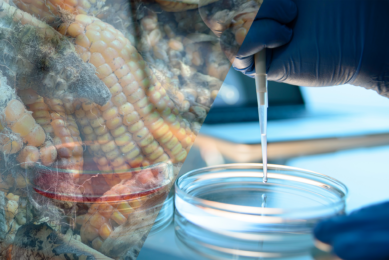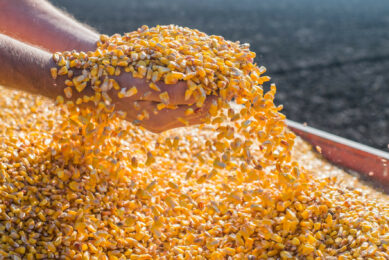Research: Impact of mycotoxins on embryo and transfer to eggs
Increased attention has been given to the presence of mycotoxins in broiler breeders’ feeds. Mycotoxins are responsible for mortality or impaired embryonic development, reduced hatchability of fertile eggs as well as reduced male and female-related fertility.
Mycotoxins levels in feeds are of direct relevance to the animal’s exposure and of indirect relevance to the products derived from the exposed animals.
Several studies have been conducted to assess the effect of mycotoxins on embryonic development and carry-over in eggs; therefore a review on the main mycotoxins known so far to be responsible for embryonic impairment and mycotoxin transfer to eggs is reported.
Aflatoxins
Recent studies have shown that aflatoxins (Afla) exposure can affect the developing immune system during embryonic development by significantly damaging DNA in B and T lymphocytes.
Embryonic exposure with aflatoxin B1 (AFB1) showed to reduce several parameters of macrophage function in chicks at 4 weeks post hatch; it was concluded that the maternal transfer of AFB1 residues to eggs reduced the post hatch immunological potential of chicks which implies that the progeny chicks would be more susceptible to disease challenges.
In agreement to these results, conclusions of another study confirmed that aflatoxin can contaminate the eggs at any stage of development.
Afla may enter the egg via the albumen and diffuse directly to the yolk, the concentration of Afla being similar between the albumen and yolk.
It was thus supposed that Afla accumulates in the genitals of chickens, turkeys and ducks, resulting in a transfer to the egg (albumen and yolk) as well as to their offspring (yolk sac and liver) (Barnard). In regards to the carry-over to eggs, it was reported that feed:egg transmission of AFB1 is about 5000:1.
Ochratoxin
Detectable levels were found in eggs of birds fed 10 mg/kg body weight. In a study laying hens received feed containing 1.3, 2.6 and 5.2 mg of ochratoxin (OTA)/kg feed. Levels in eggs were determined.
After 4 weeks exposure, concentrations in the eggs were between 0.1 and 0.2 mg/kg in egg white, independent of dose; levels in yolk increased in a dose-dependent manner from 1.6 μg/kg to 4.0 μg/kg.
According to estimations eggs may contain 0.11 % of the toxin concentrationpresent in the feed. Moreover, it was reported that hatchability was reduced due to embryonic mortality, being confirmed the teratogenicity of OTA.
Deoxynivalenol
Early studies have reported that deoxynivalenol (DON) and DON metabolite residues might be present in the eggs of laying hens expressing its teratogenic and embryotoxic effects.
Following a single oral administration of 14C-DON (2.2 mg) to laying hens, only 0.087 % (equivalent to 32 ppb) of the given doses was detected in the first egg.
When feeding was continued with 20 ppm radio-labelled DON for six days, the levels increased with each subsequent egg. Maximum levels were equivalent to 70 ng/g of DON and its metabolites in the eggs.
In another study with 5.5 mg radio-labelled DON/kg fed to six laying hens for 65 days, radioactivity in eggs increased to a maximum level of 1.7 μg DON equiv./egg at the 8th day of exposure and quickly dropped to negligible values when the exposure to DON ceased.
Furthermore, DON at levels of 38 mg/kg and 12.6 mg/kg caused embryonic deaths.
T-2 toxin
Type A-trichothecenes as T-2 toxin is known to have a hazardous effect on feed intake, growth depression, oral lesions, abnormal feathering, decreased egg production, thinner egg shells and impaired hatchability.
It is known that decreases in hatchability can be caused by reduction of feed intake of laying hens; however transfer of T-2 toxin or its metabolites to the egg may also account for decreased hatchability associated with T-2 toxicosis.
Moreover, gizzard lesions are of increasing prevalence in day old broilers, which can supposedly be transmitted from the egg. The carry-over of T-2 to eggs was observed in birds fed 0.25 mg radio-labelled T-2 toxin/ kg bodyweight.
Maximum residues in the eggs occurred 24 hours after dosing, the yolk contained 0.04% of the total dose and the white contained 0.13%.
In fact, the embryonic development depends on the toxin dosage. When high toxin doses get into the egg, the eggs will appear infertile.
At lower toxin contamination embryonic development will start but the embryo will die at a later stage of development, presenting blood- spots.
Alternatively, the fully developed embryo may fail to hatch due to its reduced vitality, or may die after hatching.
Hatchability of fertile eggs of hens was decreased when birds were fed 2 and 8 ppm. On the other side, the ingestion of moderate toxin concentrations decreases the mating disposition of male birds. Of course, these symptoms can be aggravated when other mycotoxins are co-occurring.
Zearalenone
Transmission of zearalenone (ZEA) or its metabolites into eggs needs further research. Although ZEA is ubiquitous and toxic, it appears to represent a potential danger for animals over a long time of exposure and/or in combination with other mycotoxins (synergistic effects).
In male broilers, doses of 50, 100, 200, 400 and 800 mg crystalline ZON/kg diet, had a negative effect on testes weight and at even lower levels (10 mg/ZON/kg bodyweight) the birds presented the same symptom.
Fumonisin
Thirty weeks old laying hensreceived an intravenous (2 mg/kg b.w.) or an oral dose (2 mg/kg b.w.) of 14C-FB1. Eggs were collected and separated into yolk, albumin and eggshells.
Results were negligible (< 10 – 15 ng fumonisin/g). The low carry-over rate suggests that these low residue levels do not contribute substantially to human exposure.
Conclusion
Breeders need a robust immunity to respond to vaccination programs throughout their life and to ensure the transfer of maternal immunity to their offspring in order to be protected and resistant during the first days post hatching.
An important point to take into consideration when studying the carry-over of mycotoxins to eggs, is the quality of the analytical method used.
Over the years, methods for such analyses have improved significantly becoming each time more accurate. This will bring in the future new insights on the carry-over to eggs of the different mycotoxins that are up to now unknown.
The need for a mycotoxins risk management is evident. More so if we consider the high occurrence of more than one mycotoxin on the field resulting in synergistic effects.
The combination of strategies to counteract adsorbable and non-adsorbable mycotoxins amplifies the successful protection against this wide range of harmful substances, avoiding in this way, the occurrence of embryonic deaths and mycotoxin transfer to eggs in breeders.











